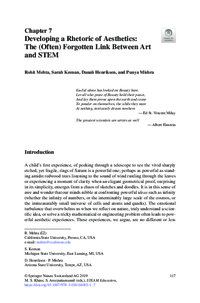Developing a Rhetoric of AestheticsThe (Often) Forgotten Link Between Art and STEM
|
 |
 Diese Seite wurde seit 6 Jahren inhaltlich nicht mehr aktualisiert.
Unter Umständen ist sie nicht mehr aktuell.
Diese Seite wurde seit 6 Jahren inhaltlich nicht mehr aktualisiert.
Unter Umständen ist sie nicht mehr aktuell.
 Zusammenfassungen
Zusammenfassungen
 Beauty, curiosity, wonder, awe, and the inherent pleasure of figuring things out are aesthetic attributes that scientists, mathematicians, and engineers often speak about when describing their motivations for engaging in STEM. In contrast, despite the robustness of evidence for the importance of the aesthetic, most arguments for learning science have focused on instrumental and functional reasons. Such an approach positions science as a tool, the value of which lies in its usefulness to externally constructed projects and goals. In this manner it trivializes the personal, affective, and humanistic nature of engaging with science and scientific ideas. In this chapter, we provide examples and an argument for a rhetoric of aesthetics that can be incorporated in a teaching. Building on a series of studies we have conducted, we offer a threefold, fractal framework that helps us integrate the aesthetic in STEM learning. The three frames in this rhetoric reside on the intersections of arts and STEM and can be seen as fuel to designing STEAM pedagogies. Finally, to move this framework into educational settings, we share several examples of how we have used this rhetoric to guide teacher professional development for STEM educators, by focusing their thinking and teaching on a more aesthetically driven STEAM view of learning.
Beauty, curiosity, wonder, awe, and the inherent pleasure of figuring things out are aesthetic attributes that scientists, mathematicians, and engineers often speak about when describing their motivations for engaging in STEM. In contrast, despite the robustness of evidence for the importance of the aesthetic, most arguments for learning science have focused on instrumental and functional reasons. Such an approach positions science as a tool, the value of which lies in its usefulness to externally constructed projects and goals. In this manner it trivializes the personal, affective, and humanistic nature of engaging with science and scientific ideas. In this chapter, we provide examples and an argument for a rhetoric of aesthetics that can be incorporated in a teaching. Building on a series of studies we have conducted, we offer a threefold, fractal framework that helps us integrate the aesthetic in STEM learning. The three frames in this rhetoric reside on the intersections of arts and STEM and can be seen as fuel to designing STEAM pedagogies. Finally, to move this framework into educational settings, we share several examples of how we have used this rhetoric to guide teacher professional development for STEM educators, by focusing their thinking and teaching on a more aesthetically driven STEAM view of learning. Dieses Kapitel erwähnt ...
Dieses Kapitel erwähnt ...
 Begriffe KB IB clear |  MINT MINT science, technology, engineering, mathematics
, science, technology, engineering, mathematics
,  Motivation Motivation motivation
, STEAM motivation
, STEAM
|
 Anderswo finden
Anderswo finden
 Volltext dieses Dokuments
Volltext dieses Dokuments
 |  Developing a Rhetoric of Aesthetics: The (Often) Forgotten Link Between Art and STEM: Artikel als Volltext bei Springerlink ( Developing a Rhetoric of Aesthetics: The (Often) Forgotten Link Between Art and STEM: Artikel als Volltext bei Springerlink ( : :  , 401 kByte; , 401 kByte;  : :  ) ) |
 Anderswo suchen
Anderswo suchen 
 Beat und dieses Kapitel
Beat und dieses Kapitel
Beat hat Dieses Kapitel während seiner Zeit am Institut für Medien und Schule (IMS) ins Biblionetz aufgenommen. Er hat Dieses Kapitel einmalig erfasst und bisher nicht mehr bearbeitet. Beat besitzt kein physisches, aber ein digitales Exemplar. Eine digitale Version ist auf dem Internet verfügbar (s.o.). Aufgrund der wenigen Einträge im Biblionetz scheint er es nicht wirklich gelesen zu haben. Es gibt bisher auch nur wenige Objekte im Biblionetz, die dieses Werk zitieren.










 Biblionetz-History
Biblionetz-History